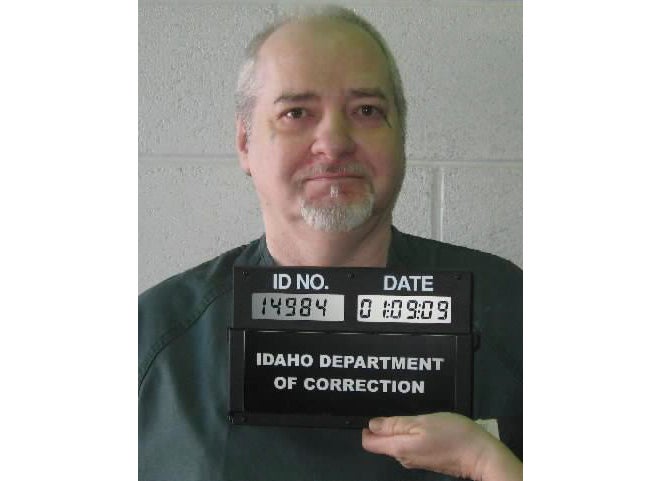What is death row future of serial killer Thomas Creech after botched execution
Creech is Idaho’s longest-serving death row prisoner but his future as a condemned man is now uncertain after lethal injection attempt cancelled after an hour reports Michelle Del Rey


Officials with the Idaho Department of Corrections attempted to put Thomas Creech, a convicted murderer to death by lethal injection for almost an hour.
The execution had been scheduled for 28 February at 10am MST. But nearly 50 minutes into the procedure, the warden called it off because officials were unable to establish an intravenous line despite previously finding eight potential access points.
The medical team behind the execution attempted to make contact in his hands, feet, legs and arms. One team member even left the execution chamber to get more supplies.
Before the attempt, Creech was given a mild sedative per departmental policy. His last meal was fried chicken, mashed potatoes, gravy and ice cream. He spent the hours leading up to the attempt with his wife.
Creech, 73, was sentenced to death after he admitted to killing 23-year-old David D Jensen, a fellow inmate, at a maximum security prison in 1981. He was previously found guilty of murdering Edward T Arnold, 34, and John W Bradford, 40, in November 1975 in Valley County.
In January, police in California determined Creech was responsible for the death of Daniel Walker.
It wasn’t the first time such a lethal injection execution had been botched, but it was a first for Idaho.
Who is Thomas Creech?
Creech has been on Idaho’s death row for 50 years, longer than any other prisoner in the state.
The number of people he’s suspected of killing has fluctuated. He told a jury in his Valley County murder trial that he was responsible for killing 42 people by the time he was 24. He later said the number was actually 26. His attorneys say that number is heavily exaggerated, according to The Idaho Statesman.
Based on reporting from the Associated Press, Creech reportedly said 11 men gang-raped his wife, Thomasene White, and then threw her off a second-story building. She survived the incident but died by suicide in an Oregon mental health hospital.
The inmate said the incident led him to track down the men he believed were responsible and kill them. In the end, Creech said he killed nine out of the 11 men.
Problems with lethal injection executions
There have been a series of issues regarding lethal injection executions across the country. The drugs needed for the method are difficult to get and in recent years it appears as though the attempts have been difficult to carry out.
Additionally, drug manufacturers have been wary of having their company’s name associated with providing the medication.
Prison officials in Alabama have botched three consecutive lethal injection executions in recent years, with the most recent being Kevin Eugene Smith’s. Smith became the first person in the world to be put to death by nitrogen hypoxia in January after his failed lethal injection attempt in 2022.
In Smith’s attempt and those of his fellow inmates, Joe Nathan James and Alan Eugene Miller, officials were unable to establish intravenous lines that would’ve put the lethal drugs into their systems.
In court filings, Smith’s attorney, Robert Grass, said the experience left his client with post-traumatic stress disorder in addition to severe physical pain.
“Alabama Department of Corrections remained willfully blind to the risk of that outcome by failing to investigate what happened and why during its immediate two previous botched and/or failed executions to prevent a recurrence before it attempted to execute Mr Smith,” the filings stated.
What’s next for Thomas Creech?
It’s unclear what officials will do after Creech’s botched execution. Speaking at a news conference following the incident, Idaho Department of Corrections Director Josh Tewalt seemed unsure about whether the department will seek another death warrant for the inmate.
After the event, Creech was returned to his cell and witnesses were escorted out of the facility.
Under Idaho law, officials could pursue another execution attempt under either lethal injection or firing squad, but Mr Tewalt said the state does not currently have the capability to carry out a firearm execution.
“This is a heavily regulated process that requires it be treated with a deference to being mindful of not violating the Eighth Amendment or creating any cruel and unusual punishment type claim,” he said.
“Our decision-making is based on our ability to carry out an execution with dignity, professionalism and respect.”
Decisions regarding whether the state would consider another death warrant for Creech would be made in the oncoming days, he added, with next steps being taken with consideration of whether the circumstances of another lethal injection attempt would be different.
Mr Tewalt said the state would not be comfortable with any type of surgical intervention to execute the prisoner, though such policies exist in other states.
When asked a question about potentially using nitrogen hypoxia in another execution attempt, the director said that for the state to implement the method, lawmakers would need to pass legislation allowing for its use.
Such measures have been taken in Oklahoma and Mississippi. After Smith’s execution, lawmakers in Ohio introduced legislation to add nitrogen gas as an execution method.
Attorneys for Creech immediately filed a new motion with a US District Court stating that “the badly botched execution attempt” proves Idaho’s “inability to carry out a humane and constitutional execution,” according to CBS.
The attorneys previously filed three motions with the US Supreme Court to stay the execution but they were denied on Wednesday morning, leading officials to transport Creech on a gurney to the execution chamber.